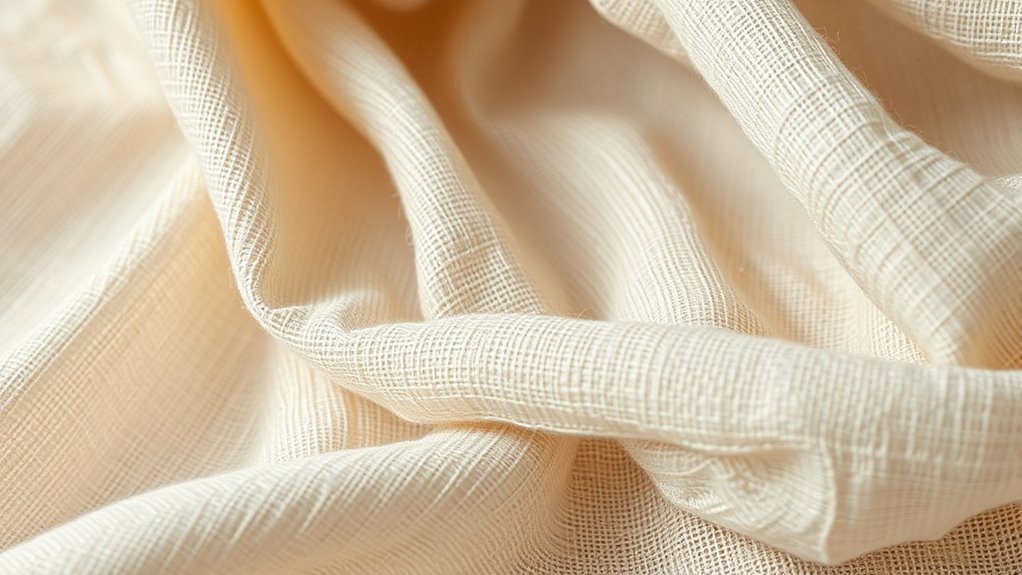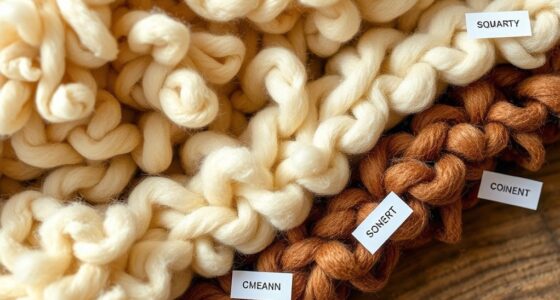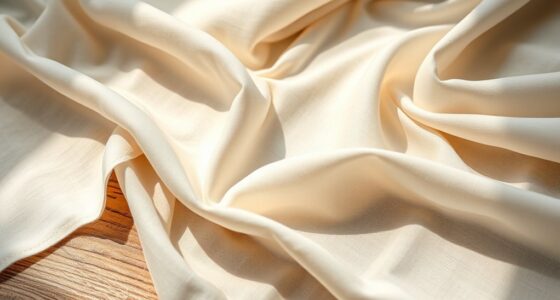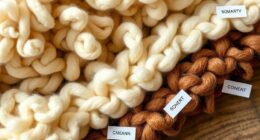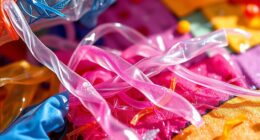Linen fabric starts with cultivating flax—a sustainable crop that needs less water and pesticides. Once harvested, the fibers are extracted through natural retting, which uses moisture and microbes to break down stalks. These fibers are then cleaned, combed, and spun into yarns, resulting in a durable, breathable fabric with a natural finish. If you want to explore each stage’s eco-friendly practices and how they influence linen’s quality, keep exploring further.
Key Takeaways
- Flax plants are sustainably cultivated with eco-friendly practices like crop rotation and minimal pesticide use.
- Harvesting involves retting, where natural moisture and microbes break down stalks to extract fibers.
- Linen fabric is produced by cleaning, combing, and spinning flax fibers into yarns, ensuring strength and durability.
- Natural and modern dyeing techniques use eco-friendly dyes for vibrant, sustainable colors on linen fabric.
- Sustainable linen production preserves environmental health, resulting in high-quality, durable, and timeless fabric.
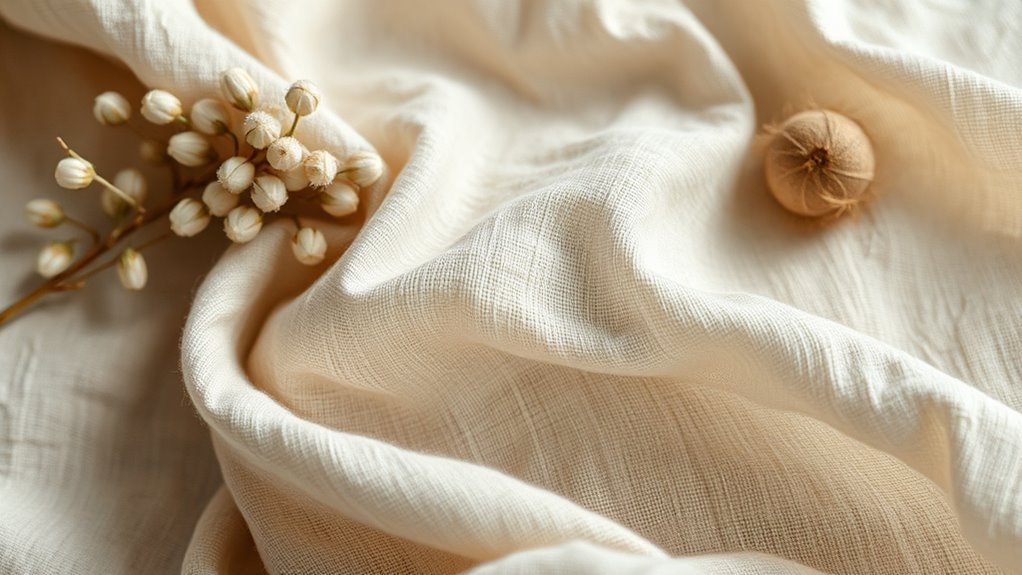
Are you curious about linen fabric and what makes it a popular choice for clothing and home textiles? The journey from the flax plant to the luxurious cloth involves a fascinating combination of sustainable farming practices and refined fabric dyeing techniques. When it comes to sustainable farming, flax cultivation stands out because it requires less water and fewer pesticides compared to other crops. This eco-friendly approach minimizes environmental impact, making linen a more sustainable textile option. Farmers often choose crop rotation and natural pest control methods, which preserve soil health and promote biodiversity. By supporting linen made from flax grown sustainably, you’re helping reduce the ecological footprint of your wardrobe or home decor.
Once the flax plants are harvested, the process of transforming raw fibers into fabric begins. The fibers are extracted through a process called retting, where natural moisture and microbes break down the stalks, freeing the fibers. After retting, the fibers are cleaned, combed, and spun into yarns. This process requires careful handling to maintain fiber strength and quality, which ultimately influences the durability and texture of the final fabric. Linen’s natural appeal stems from its smooth, breathable, and moisture-wicking qualities, making it ideal for warm climates and comfortable wear.
Transforming flax into linen involves retting, cleaning, combing, and spinning to create durable, breathable fabric.
The dyeing process is another essential step that enhances linen’s appeal, and fabric dyeing techniques have evolved to be both beautiful and environmentally considerate. Traditional dyeing methods often used natural dyes derived from plants, insects, or minerals, which complement linen’s eco-friendly reputation. Modern techniques now combine natural dyes with innovative dyeing methods that minimize water usage and chemical runoff. For example, eco-dyeing methods employ low-impact dyes and controlled processes that reduce waste and energy consumption. These sustainable dyeing practices ensure that the vibrant colors of linen fabrics are achieved without compromising the environment, giving you peace of mind about the origins and ecological impact of your textiles.
As you can see, the journey of linen from plant to product involves thoughtful, sustainable practices and advanced dyeing techniques. This commitment to eco-conscious processes not only preserves the integrity of the environment but also guarantees that you receive a high-quality, durable fabric that ages beautifully. When you choose linen, you’re supporting a sustainable approach to fashion and home textiles—one that values environmental health, craftsmanship, and timeless elegance. Understanding these steps helps you appreciate why linen remains a beloved fabric worldwide, blending tradition with modern sustainability efforts for a truly luxurious and responsible choice.
Frequently Asked Questions
How Eco-Friendly Is Linen Production Compared to Other Fabrics?
Linen production is quite eco-friendly because it relies on sustainable farming practices and uses less water compared to other fabrics like cotton. You’ll find that flax plants need fewer pesticides and fertilizers, reducing environmental impact. Additionally, linen’s water conservation benefits make it a more sustainable choice. By choosing linen, you’re supporting eco-conscious manufacturing and helping protect natural resources.
What Are the Best Care Tips to Prolong Linen’s Lifespan?
Imagine you’re in the roaring twenties, and you want your linen to last. To do so, you should wash linen in cold water, avoid harsh chemicals, and promptly treat stains with gentle stain removal techniques. Iron linen while damp using a medium heat setting, and avoid over-ironing to prevent damage. Proper care guarantees your linen remains beautiful, soft, and durable for years to come.
Can Linen Fabric Be Blended With Other Fibers Effectively?
Yes, linen fabric can be blended effectively with other fibers like cotton, silk, or polyester. This fiber blending enhances fabric durability, making it more resistant to wear and tear while maintaining the luxurious feel of linen. Blending also improves ease of care and can add different textures or finishes. When you choose blended linen fabrics, you get a balance of natural elegance and increased durability, perfect for a variety of applications.
How Does Linen Perform in Different Climates and Weather Conditions?
Linen performs well across various climates due to its climate adaptability and weather resilience. In hot, humid weather, you’ll find it breathable and cool, perfect for staying comfortable. During cooler months, linen’s moisture-wicking properties help regulate temperature. Its natural fibers resist wrinkling and retain strength, making it suitable for diverse environments. Overall, linen’s versatility guarantees you stay comfortable, no matter the weather conditions.
What Are the Latest Innovations in Linen Fabric Technology?
You’ll love the latest linen innovations, especially smart dyeing techniques that create vibrant, long-lasting colors with eco-friendly processes. Fiber enhancement technologies also boost linen’s strength, softness, and moisture-wicking abilities, making it more durable and comfortable. These advancements mean your linen garments stay beautiful longer, resist wrinkles better, and feel even more luxurious. Embrace these innovations for a smarter, more sustainable wardrobe that combines tradition with cutting-edge performance.
Conclusion
Now that you’ve uncovered the journey from flax plant to luxurious linen fabric, you’re like a skilled navigator steering through a sea of fibers. With this knowledge, you can appreciate linen’s timeless elegance and durability even more. Whether you’re choosing a shirt or a sheet, remember that each piece carries the story of nature and craftsmanship. Embrace linen’s natural charm—it’s a treasure chest of history woven into every thread you wear or use.
